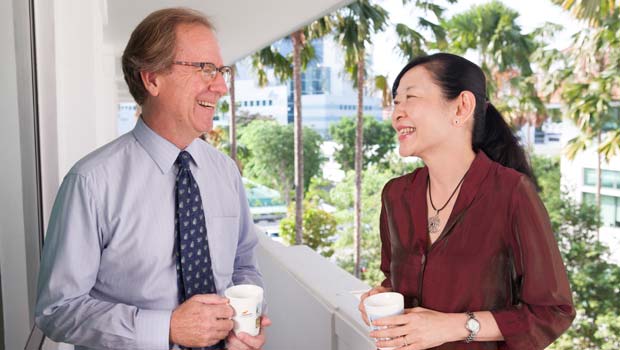
As our SingHealth and Duke-NUS partnership enters the next decade, how do we measure up to the well-known Academic Medical Centres in the world? We met with SingHealth Group CEO Prof Ivy Ng and Prof Thomas Coffman, Dean of Duke-NUS Medical School, to find out.
Ten years is hardly a significant period of time if you look at the histories of illustrious Academic Medical Centres (AMCs). Giants like Mayo and Cleveland Clinics have had multiple decades of growth and advancement to get to where they are today.
The SingHealth Duke-NUS Academic Medical Centre has chalked a list of significant milestones in its first decade.
“The achievements made by SingHealth and Duke-NUS as partners have been remarkable,” said Prof Coffman.
“We are progressing well,” agreed Prof Ng.
“But a healthy discontent with the present is important to help motivate all of us to keep pushing forward for new developments and innovations for better patient care.”
Both leaders were quick to add that the SingHealth Duke-NUS AMC has several features that make it unique compared to other AMCs around the world.
“For one, our AMC has a global reach, allowing us to leverage on the rich tradition of the parent organisations – SingHealth, Singapore’s largest public healthcare provider, Duke-NUS medical school – along with a renowned institution in the US, Duke University,” said Prof Coffman.
“SingHealth and Duke-NUS are separate organisations, yet we have a joint leadership that drives our agenda for Academic Medicine and to form Academic Clinical Programmes (ACPs) across institutions,” said Prof Ng.
“We enjoy a unique position in Asia that gives our AMC an opportunity to better understand Asian diseases and conduct relevant and ground breaking research in diseases that afflict the local and regional population.”
What also sets SingHealth Duke-NUS apart from other AMCs is the close physical location of the different institutes. This makes it easy for clinicians, educators and researchers from primary to tertiary and intermediate-and-long-term-care sectors to work together.
“Another unique feature of our AMC is that it works with three medical schools, while other AMCs usually train students from only one school. We also play a key role in training the range of healthcare staff including nursing and allied health professionals,” said Prof Ng.
Asked what new plans the AMC has in the pipeline, the two leaders shared that the ACPs and SingHealth-Duke NUS Disease Centres (SDDCs) will be strengthened and expanded.
Three more ACPs will be rolled out in the next two years, bringing the total number to 14. More SDDCs will also be set up to add on to the existing six. By bringing together sub-specialities across institutions and ACPs, SDDCs maximise their collective expertise to offer interprofessional, patient-centred care.
Two new joint research institutes will be set up to focus on cancer and emerging infectious diseases. They will join the already established National Neuroscience Research Institute Singapore (NNRIS), National Heart Research Institute Singapore (NHRIS), Institute of Precision Medicine (PRISM) and Health Services Research Institute (HSRI).
Armed with the experience from the last decade, the two leaders expressed that ensuring efficient resource utilisation is a challenge. Putting many different plans in place also requires time and the cooperation of different groups of people.
“But what has made all the changes exciting is the vibrancy of the different teams coming together from different sectors of the campus.
Collaborations have transformed our work in all domains, and this is what makes the AMC a very attractive place to work. Our teams deserve to be recognised for this,” said Prof Coffman.
With the many exciting plans ahead, Prof Ng and Prof Coffman are looking forward to an even more vigorous, dynamic AMC where a healthy discontent keeps everyone aiming to transform care.













 Get it on Google Play
Get it on Google Play